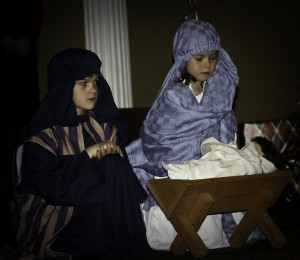
During Advent I went one Wednesday night to St. George Antiochian Orthodox Cathedral in Pittsburgh. I was surprised to hear a service that was new to me: Not the ordinary Vespers, but the “Advent Paraklesis.”
As in so much of Orthodox worship, the hymns carry a huge freight of theology. As always there is much reveling in the paradoxes of salvation, especially the mystery of the Second Person of the Trinity who made heaven and earth allowing himself to dwell in the tiny space of Mary’s womb.
But in this particular service I was struck by one subset of hymns. They took a close and imaginative look at the thoughts of Mary, Jesus’ mother, upon his birth.
How many Christmas pageants have I seen in which Mary brings forth the child who will save humanity, but is given not a single line of reflection on the event?
The little girl in a costume made from a table cloth just sits in the tableau, silent.
It’s worth exploring the idea of how Mary celebrated the birth of Jesus. I’ve always thought that mothers should be the ones who to be thrown parties on their children’s birthdays. They did all the hard work.
Celebrating the Birth of Jesus with His Mother
So let’s give a listen to the centuries-old imaginings of what Mary might have been thinking, and praying, and singing as she snuggled her newborn during the 12 Days of Christmas. These are scattered amid other hymns in the last half of the service.
What is this great and strange wonder?
How do I uphold thee who upholds all the world by thy Word?
O my Son who art without beginning, thy birth is beyond all speech.
The heavenly throne is consumed in flames as it holds thee;
how is it, then, that I carry thee, my Son?
Thou dost bear the likeness of thy Father, O my Son.
How then hast thou become poor and taken upon thyself the likeness of a servant?
How shall I lay thee in a manger of beasts without reason, who dost deliver all men from unreason?
I sing the praises of thy compassion.
O sweetest Child, how shall I feed thee who givest food to all?
How shall I hold thee who holdest all things in thy power?
How shall I wrap thee in swaddling clothes, who dost wrap the whole world in clouds?
May these days of Christmas be full of reflection, praise, and prayer for you too. I pray God may give you richest blessings, and signs of the new life Christ was born to bring.
(If you want to hear some Advent and Christmas music in the Byzantine tradition, check out this CD by the choir of St. George Cathedral. Great stuff…)
————
I’d love to send you a free copy of my new eBook on quirky and surprising saints. It’s called Role Models for Discipleship.
Click the button and I’ll send it along.
————
This post contains an affiliate link.

It’s the paradoxical mystery, hidden from all eternity (as they say). It’s deep stuff to draw us ever deeper into the mystery of Christ.
Amen!
How fascinating! I think of Mary pondering these things in her heart. In Luke, she always seems to pondering — a great model for us. Maybe this liturgy reflects what she was pondering…
Yes! That is exactly what I was trying to suggest, but I seem to have neglected to note the “pondered these things in her heart” reference…
Gary I am just beginning to read the book Deep Work authored by Cal Newport. Heard him on TED Talks last year.. The discipline of pondering deeply is left begging in our times. Mystery is a deep work for Christians that will help lead to our sanctification. Have yourself a great season focusing on water. Ahh the waters of NT full immersion are my Epiphanal Joy.
Thanks Jimmy. I’ll have to look up the TED talk and the book. It sounds like great stuff.